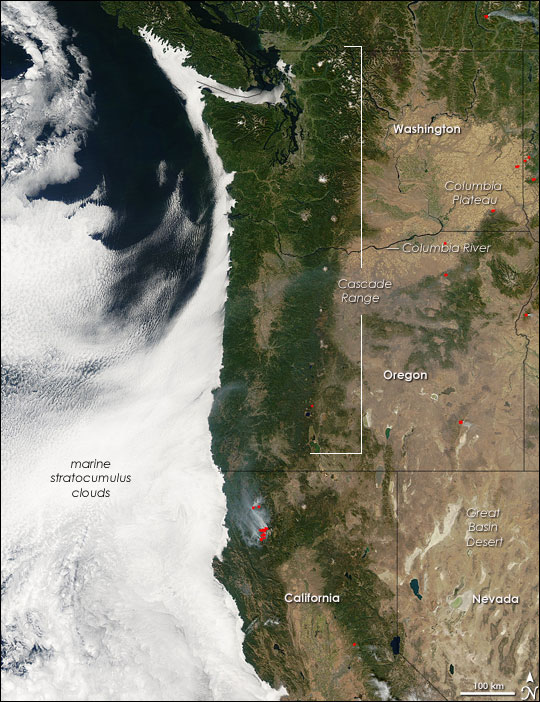I’ve received many more requests about the new disappearing-clouds study than the “gold standard proof of anthropogenic warming” study I addressed here, both of which appeared in Nature journals over the last several days.
The widespread interest is partly because of the way the study is dramatized in the media. For example, check out this headline, “A World Without Clouds“, and the study’s forecast of 12 deg. C of global warming.
The disappearing clouds study is based upon the modelling of marine stratocumulus clouds, whose existence substantially cools the Earth. These extensive but shallow cloud decks cover the subtropical ocean regions over the eastern ocean basins where upwelling cold water creates a strong boundary layer inversion.

In other words, the cold water causes a thin marine boundary layer of chilled air up to a kilometer deep, than is capped by warmer air aloft. The resulting inversion layer (the boundary between cool air below and warm air aloft) inhibits convective mixing, and so water evaporated from the ocean accumulates in the boundary layer and clouds then develop at the base of the inversion. There are complex infrared radiative processes which also help maintain the cloud layer.
The new modeling study describes how these cloud layers could dissipate if atmospheric CO2 concentrations get too high, thus causing a positive feedback loop on warming and greatly increasing future global temperatures, even beyond what the IPCC has predicted from global climate models. The marine stratocumulus cloud response to warming is not a new issue, as modelers have been debating for decades whether these clouds would increase or decrease with warming, thus either reducing or amplifying the small amount of direct radiative warming from increasing CO2.
The new study uses a very high resolution model that “grows” the marine stratocumulus clouds. The IPCC’s climate models, in contrast, have much lower resolution and must parameterize the existence of the clouds based upon larger-scale model variables. These high resolution models have been around for many years, but this study tries to specifically address how increasing CO2 in the whole atmosphere changes this thin, but important, cloud layer.
The high resolution simulations are stunning in their realism, covering a domain of 4.8 x 4.8 km:
The main conclusion of the study is that when model CO2 concentrations reach 1200 ppm or so (which would take as little as another 100 years or so assuming worst-case energy use and population growth projections like RCP8.5), a substantial dissipation of these clouds occurs causing substantial additional global warming, with up to 12 deg. C of total global warming.
Shortcomings in the Study: The Large-Scale Ocean and Atmospheric Environment
All studies like this require assumptions. In my view, the problem is not with the high-resolution model of the clouds itself. Instead, it’s the assumed state of the large-scale environment in which the clouds are assumed to be embedded.
Most importantly, it should be remembered that these clouds exist where cold water is upwelling from the deep ocean, where it has resided for centuries to millennia after initially being chilled to near-freezing in polar regions, and flowing in from higher latitudes. This cold water is continually feeding the stratocumulus zones, helping to maintain the strong temperature inversion at the top of the chilled marine boundary layer. Instead, their model has 1 meter thick slab ocean that rapidly responds to only whats going on with atmospheric greenhouse gases within the tiny (5 km) model domain. Such a shallow ocean layer would be ok (as they claim) IF the ocean portion of the model was a closed system… the shallow ocean only increases how rapidly the model responds… not its final equilibrium state. But given the continuous influx of cold water into these stratocumulus regions from below and from high latitudes in nature, it is far from a closed system.
Second, the atmospheric environment in which the high-res cloud model is embedded is assumed to have similar characteristics to what climate models produce. This includes substantial increases in free-tropospheric water vapor, keeping constant relative humidity throughout the troposphere. In climate models, the enhanced infrared effects of this absolute increase in water vapor leads to a tropical “hot spot”, which observations, so far, fail to show. This is a second reason the study’s results are exaggerated. Part of the disappearing cloud effect in their model is from increased downwelling radiation from the free troposphere as CO2 increases and positive water vapor feedback in the global climate models increases downwelling IR even more. This reduces the rate of infrared cooling by the cloud tops, which is one process that normally maintains them. The model clouds then disappear, causing more sunlight to flood in and warm the isolated shallow slab ocean. But if the free troposphere above the cloud does not produce nearly as large an effect from increasing water vapor, the clouds will not show such a dramatic effect.
The bottom line is that marine stratocumulus clouds exist because of the strong temperature inversion maintained by cold water from upwelling and transport from high latitudes. That chilled boundary layer air bumps up against warm free-tropospheric air (warmed, in turn, by subsidence forced by moist air ascent in precipitation systems possibly thousands of miles away). That inversion will likely be well-maintained in a warming world, thus maintaining the cloud deck, and not causing catastrophic global warming.

 Home/Blog
Home/Blog




https://pg-slot.game/%e0%b8%9a%e0%b8%a3%e0%b8%b4%e0%b8%81%e0%b8%b2%e0%b8%a3/pg-slot-login/“>pg slot login ทางเข้าแห่งความหรรษา ที่ทุกท่านจะได้รับหลังจากที่เข้าสู่ระบบ กับเว็บ สล็อต ออนไลน์ของเรา กับ สล็อตออนไลน์ที่ดีที่สุด แตกบ่อยที่สุด ปลอดภัยที่สุดวนปี 2022 นี้
pg slot ฝาก 50 รับ 100ต้นแบบให้เลือกรับโดยจะมีการเปลี่ยนแปลงไปเรื่องๆจะเปิดตามโอกาศหรือกิจกรรมต่างๆกับเว็บไซต์ของพวกเราพีจีสล็อตที่จะให้แก่คุณบันเทิงใจกับเกมสล็อตPG https://pg-slot.game/